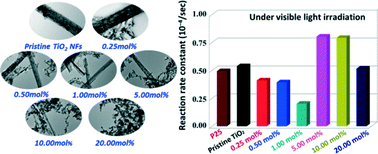Bismuth doping effect on TiO2 nanofibres for morphological change and photocatalytic performance†
Abstract
Doping bismuth ions into photocatalytic materials is one of the most effective methods for preparing highly visible-light-active photocatalysts. In order to develop high-performance photocatalytic materials that are easy to produce, even in industrial quantities, we developed a facile method to prepare bismuth-doped titanium dioxide (Bi-doped TiO2) by hydrothermal synthesis followed by thermal annealing treatment. Bi-doped TiO2 can be applied in the field of photodecolorization of organic dye and photocatalytic hydrogen generation. High concentration doping (>5.00 mol%) resulted in the morphological change of Bi-doped TiO2 from nanofibre to nanorod observed by transmission electron microscopy. The crystal structure evolution and elemental composition were analysed by combining Raman spectroscopy, X-ray crystallography and X-ray photoelectron spectroscopy. For the photodegradation of organic dye methyl orange, all Bi-doped TiO2 showed less activity than pristine TiO2 nanofibres under UV irradiation. 5.00 mol% and 10.00 mol% Bi-doped TiO2 showed higher activities than pristine TiO2 nanofibres under visible light irradiation. For the photocatalytic hydrogen generation measurement, none of the Bi-doped TiO2 showed a detectable value under visible light irradiation. However, under UV irradiation, various Bi-doped TiO2 catalysts exhibited a detectable photocatalytic hydrogen production rate. 0.50 mol% Bi-doped TiO2 exhibited the highest performance. The result could be due to the relatively lower overpotential for hydrogen production. Our study developed a series of visible-light-active Bi-doped TiO2 catalysts, and it could replace the traditional TiO2 catalysts decorated with a high-cost noble metal.


 Please wait while we load your content...
Please wait while we load your content...